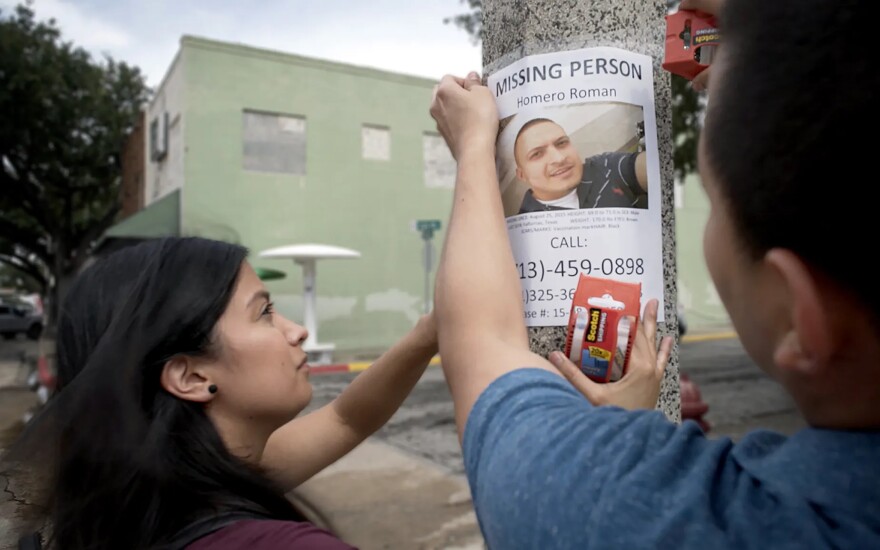In 2021, as more migrants crossed through Far West Texas, the region also saw a sharp increase in migrant deaths. A new documentary, "Missing in Brooks County," offers lessons and a warning from South Texas, which sees more migrant deaths than anywhere else in the country.
By Annie Rosenthal
In 2021, as the number of migrants crossing through Far West Texas increased, so did the number of migrant deaths. In Culberson County, which previously saw an average of one death a year, the sheriff says 30 sets of remains were recovered last year alone.
These deaths are not new to Texas –– more remains are recovered here than in any other state. But for decades, those deaths have been concentrated in South Texas, where more than 3,000 remains have been recovered since the late 1990s.
That region and history are at the center of a new documentary called " Missing in Brooks County." Marfa Public Radio’s border reporter, Annie Rosenthal, recently spoke with the film’s co-director, Lisa Molomot, and one of its protagonists, Omar Román Gómez, about what Far West Texas can learn from South Texas as this region begins to face the same crisis.
Highlights from the Conversation
On why so many migrants have died or disappeared in rural areas of Texas
Seventy miles north of the border in South Texas, Brooks County is the site of an immigration checkpoint that migrants walk long distances to avoid. Trekking for days through remote ranches where clean water is hard to find, many succumb to dehydration and exposure.
Molomot explains that this started happening all along the border in the 1990s, when the U.S. Border Patrol implemented a new strategy called Prevention Through Deterrence. “Instead of migrants coming through ports of entry like San Diego and El Paso, these safer routes were closed off, and it forced migrants to cross in more clandestine areas and obviously, more dangerous areas,” she says. “The hope was that if there were some deaths that people would, migrants would stop coming, because of the deaths. But that's not the situation because the need to migrate hasn't changed. If anything, with climate change, it's becoming greater.”
Border Patrol has tallied more than 8,000 sets of remains found on the U.S.-Mexico border since the late 1990s. But, as Molomot explains, that number only includes remains that were found when Border Patrol agents were present. “They are not always present. And on top of that, so many migrants go missing and are never found,” she said. The Brooks County sheriff estimates that only one in five remains are recovered –– so Molomot says the true death tally could be closer to 40,000.
https://vimeo.com/459473705
On the challenges of searching for missing migrants in Texas
In Arizona, where Molomot lives, NGOs helping families look for missing migrants work hand in hand with a county medical examiner’s office to identify remains. But many counties in Texas, including Brooks County, don't have their own medical examiner. "It's a completely different system," Molomot says. "In fact, there is no system, really."
In Brooks County, a man named Eddie Canales has started a small organization called the South Texas Human Rights Center to search for the missing.
“He basically receives calls all day long from families who are looking for their loved ones," Molomot says. "He puts out water for migrants on private ranches if ranch owners allow him to." Canales also works with an anthropologist at Texas State University who is using DNA to identify the remains of migrants buried anonymously around South Texas.
In Far West Texas, Culberson County Sheriff Carrillo told Marfa Public Radio, there isn’t yet the same kind of infrastructure. Most of his help in recovering remains has come from a group of volunteers called Aguilas del Desierto, who travel the Southwest combing the desert for missing migrants.
“You can’t dismiss it and say, you know what, it’s not my job. Because it is, and we’ll help,” Carrillo says. “What's sad is I have to resort to a non-governmental entity like the Aguilas to help search for bodies because nobody's looking for these bodies. And we do have several that have been reported missing that we hadn't found that we suspect may be out there.”
On what it’s like to search for a loved one without answers
Omar Román Gómez’s brother, Homero, was brought to the U.S. as a five year old and grew up in Texas. He was deported back to Mexico when he was 27. After two years, he tried to return to the U.S. to reunite with his family –– but the smuggler who brought Homero through Brooks County said he couldn’t keep up with the group and was left behind.
Román and his family have been searching for Homero for seven years, even traveling to Brooks County to comb the desert themselves. But remains they found turned out not to belong to Homero.
“It’s been really hard all these years, just not knowing what to do next,” Román says. “Having that faith that hopefully one day, somebody calls us and tells us, 'Hey, we found Homero.' Whether it’s alive or dead, we just want closure.”
He also has a message for people in Far West Texas. “I want them to know that Homero, he wasn’t a bad person,” he said. “I just want them to know that most of the migrants coming over, they’re not here to harm nobody,” he said. “They want to work and have a good life.”
"Missing in Brooks County" will be streaming for free on PBS.org through the end of February.
If you have a family member who has gone missing crossing the border, Sheriff Oscar Carrillo recommends reaching out to your local consulate so they can take a DNA sample and see if they can find a match.





